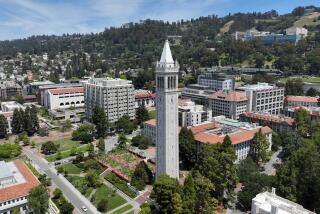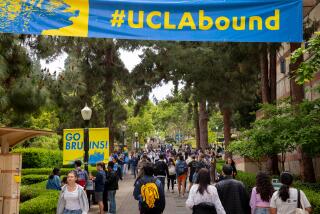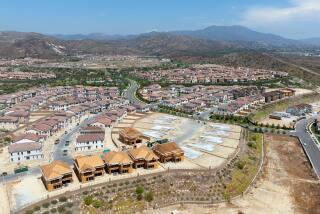Construction Boom Is Keeping UC Irvine Humming
- Share via
IRVINE — The joke is UCI stands for “Under Construction Indefinitely.”
And with all the hard hats and bricks and mortar around this 31-year-old campus, it’s easy to see the humor.
But the construction, the largest boom since UC Irvine’s founding, is serious, and sometimes controversial, business.
Administrators see it as crucial to accommodating the growing enrollment, which has climbed 22% in the last decade, to 15,852, and is projected to increase 25% in another 10 years--making it the fastest-growing UC campus, said Vice Chancellor Wendell C. Brase.
As a result, the bulldozers are growling and the hammers are nailing on several projects that total a quarter-million square feet and cost $64 million, most of that from state bond money, student fees and private sources.
On Wednesday, the eve of the first Board of Regents meeting on campus in six years, members of the buildings and grounds committee donned hard hats and toured two of the projects, the new humanities building and the William R. Gillespie Neuroscience Research Facility, both of which are scheduled to open by fall.
Also recently completed or almost done are a $3-million new top floor for the cancer research center and the $4-million Qureshey Center for Neurobiology, Learning and Memory. A new music department building also is planned in the next few years, across the street from the new humanities building, along with a $20-million medical school lab.
Last summer, a $30-million social sciences building opened, and within the next several years the university is planning to develop housing and other projects on the east side of the campus, with a new student recreation center serving as a hub.
The construction boom is not without detractors. The planned student recreation center has drawn complaints that it would displace retired workhorses and pets that for 25 years have had a home at a 75-acre pasture on university land. The nearby Farm School, an alternative school, has not been included in long-range plans, to the consternation of parents.
The university has said it would help both look for new land.
The regents’ tour stayed clear of that area.
Instead, they got up-close looks at showcase buildings--and learned from Assistant Vice Chancellor Rebekah Gladson that the university is not building on the cheap.
As she guided them through the $15.8-million humanities building and $21-million neuroscience research facility, she rattled off amenities for which the university paid extra: in the humanities building, not two-, but four-hinge doors to better withstand slamming. Specially designed windows that resist heat from the sun and include a decidedly low-tech plus: They can be opened (fixed windows are the standard).
In the Gillespie building, a filtering system in animal holding rooms can recirculate air 16 times an hour--and more or less if the computer controlling it says so. Extra-strength counter tops in the labs are designed to resist chipping and heat damage.
All in all, these extras added about 1% to the cost of the buildings. But Vice Chancellor Wendell C. Brase said the features should save energy costs and lessen the chance they will need major maintenance over 20 years.
The regents seemed impressed, and none openly challenged the costs.
Student Regent Jess M. Bravin, a Berkeley law student, said, “I’m not in a position to judge if a door lock should cost $18 or $20, not being an expert in the building fixture area.”
He said he was particularly pleased to see that the design of the humanities building allows for a small plaza in front, with a bridge across a nearby street to a planned music building.
“It seems they have given some thought not only to technical requirements but also to the human dimension,” Bravin said. “I’m impressed with what I have seen so far.”
Regent Meredith J. Khachigian, who lives in Irvine, said the buildings are needed on a campus growing so fast, even if horse stables must go.
“I think we’re always worried about disruptions, but everybody should understand these are necessary goals,” she said.
Just how long this will go on is uncertain. The university’s plans call for a student population no greater than 26,050, though Brase said the figure could be adjusted depending on enrollment trends over the next several years.
The construction, he said, “I expect to continue.”
More to Read
Sign up for Essential California
The most important California stories and recommendations in your inbox every morning.
You may occasionally receive promotional content from the Los Angeles Times.










